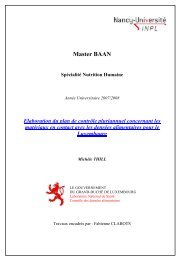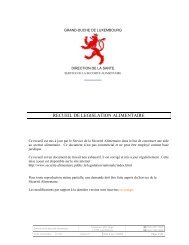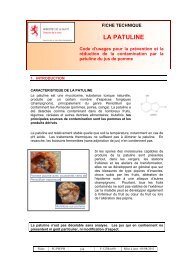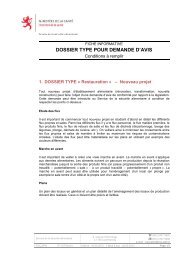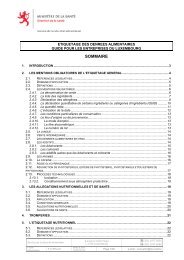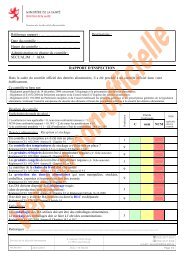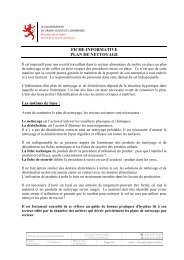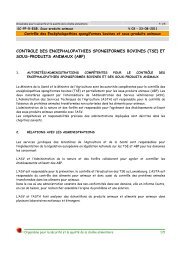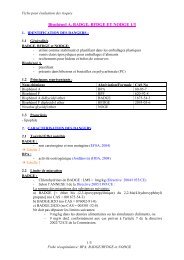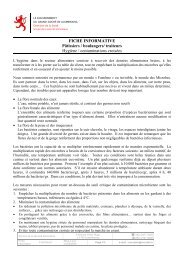Food contact materials
Food contact materials
Food contact materials
Create successful ePaper yourself
Turn your PDF publications into a flip-book with our unique Google optimized e-Paper software.
<strong>Food</strong> <strong>contact</strong> <strong>materials</strong><br />
In-house documentation<br />
Nordic check lists to industry and trade
<strong>Food</strong> <strong>contact</strong> <strong>materials</strong><br />
In-house documentation: Nordic check lists to industry and trade<br />
ANP 2008:709<br />
© Nordic Council of Ministers, Copenhagen 2008<br />
ISBN 978-92-893-1645-3<br />
Print: Saloprint, Copenhagen 2008<br />
Design: Par No 1<br />
Copies: 1,300<br />
Printed on environmentally friendly paper<br />
This publication can be ordered on www.norden.org/order.<br />
Other Nordic publications are available at<br />
www.norden.org/publications<br />
Printed in Denmark<br />
Nordic Council of Ministers Nordic Council<br />
Store Strandstræde 18 Store Strandstræde 18<br />
DK-1255 Copenhagen K DK-1255 Copenhagen K<br />
Phone (+45) 3396 0200 Phone (+45) 3396 0400<br />
Fax (+45) 3396 0202 Fax (+45) 3311 1870<br />
www.norden.org<br />
Nordic co-operation<br />
Nordic cooperation is one of the world’s most extensive forms<br />
of regional collaboration, involving Denmark, Finland, Iceland,<br />
Norway, Sweden, and three autonomous areas: the Faroe Islands,<br />
Greenland, and Åland.<br />
Nordic cooperation has firm traditions in politics, the economy,<br />
and culture. It plays an important role in European and international<br />
collaboration, and aims at creating a strong Nordic community in a<br />
strong Europe.<br />
Nordic cooperation seeks to safeguard Nordic and regional<br />
interests and principles in the global community. Common Nordic<br />
values help the region solidify its position as one of the world’s<br />
most innovative and competitive.
<strong>Food</strong> <strong>contact</strong> <strong>materials</strong><br />
In-house documentation<br />
Nordic check lists 1) to industry and trade<br />
Producer<br />
Chemicals/raw <strong>materials</strong> (starting substances)<br />
Producer<br />
Polymer/intermediates<br />
Producer<br />
FCM<br />
Importer<br />
FCM<br />
Producer<br />
<strong>Food</strong>stuffs<br />
Importer/trade<br />
<strong>Food</strong>stuffs<br />
Retailer<br />
Consumer<br />
1)<br />
Extract of report; Full text to be found on http://www.norden.org/pub/sk/<br />
Members of this project group consist of the following persons:<br />
Denmark: Bente Fabech, Per Rathmann Hansen and Jan Petersen, Danish Veterinary and <strong>Food</strong> Administration;<br />
Finland: Pirkko Kostamo, Evira (National <strong>Food</strong> Administration) and Vesa Tuomaala, Ministry of Industry and Trade;<br />
Iceland: Grimur Olafsson, Environmental & <strong>Food</strong> Agency of Iceland; Norway: Per Fjeldal, Norwegian <strong>Food</strong> Control<br />
Authority and Sweden: Maria Florin, National <strong>Food</strong> Administration<br />
3
<strong>Food</strong> <strong>contact</strong> <strong>materials</strong> - In-house documentation: Nordic check lists to industry and trade<br />
A. Introduction<br />
<strong>Food</strong> <strong>contact</strong> <strong>materials</strong> are a potential source of contamination of all types of foods. <strong>Food</strong>s are<br />
normally in <strong>contact</strong> with one or several types of food <strong>contact</strong> <strong>materials</strong>, like packaging, including<br />
multilayer <strong>materials</strong>, process equipment etc.<br />
<strong>Food</strong> <strong>contact</strong> <strong>materials</strong> shall comply with the legislation and in-house control in industry and<br />
trade is a tool to prevent violation of the legislation. Furthermore, in-house control are important<br />
pre-requisites to limit this contamination, e.g. in-house control based on declaration of<br />
compliance and documentation at the producers and importers.<br />
B. What are food <strong>contact</strong> <strong>materials</strong>?<br />
<strong>Food</strong> <strong>contact</strong> <strong>materials</strong> and articles (in the following abbreviated FCM) comprise a broad and<br />
complex area. Many different types of <strong>materials</strong> are used like plastics, paper, metals, woods,<br />
lacquers, adhesives, printing inks etc. The <strong>materials</strong> are used either as single <strong>materials</strong> or<br />
combinations e.g. in complex multilayer <strong>materials</strong>. Furthermore, many different substances<br />
are used in the <strong>materials</strong>, as e.g. monomers or additives like plasticizers, stabilisers, solvents<br />
and pigments. An estimation of the total number of chemicals used is 10.000’s and only lower<br />
percent of these chemicals have been assessed by the EU Scientific panels in EFSA 2) for the use<br />
in FCM and possible migration and potentials safety effect on consumer health.<br />
C. EU legislation<br />
Regulation no.1935/2004 on <strong>materials</strong> and articles intended to come into <strong>contact</strong> with foods<br />
is the framework regulation covering all types of FCM. The general requirements are as follows:<br />
FCM shall – under normal and foreseeable conditions of use – not transfer their constituents<br />
into foodstuffs in quantities, which could:<br />
a. Endanger human health<br />
b. Bring about an unacceptable change in the composition of the foodstuffs or<br />
c. Bring about de te ri o ration in the organoleptic characteristics thereof.<br />
This regulation applies to FCM, including active and intelligent FCM, which in their finished<br />
state are:<br />
a. Intended to be brought into <strong>contact</strong> with food; or<br />
b. Already brought into <strong>contact</strong> with food and are intended for that purpose; or<br />
c. Can reasonably be expected to be brought into <strong>contact</strong> with food or to transfer their<br />
constituents to food under normal or foreseeable conditions of use.<br />
The regulation does not apply to FCM which are supplied as antiques, covering or coating<br />
<strong>materials</strong>, such as the <strong>materials</strong> covering cheese rinds, prepared meat products or fruits,<br />
and which form part of the food and may be consumed together with this food nor to fixed<br />
public or private water supply equipment.<br />
In addition to the general legislation, EU has specific legislation on plastic, ceramics and<br />
regenerated cellulose and on good manufacturing practise at the producers of food <strong>contact</strong><br />
<strong>materials</strong> and the intermediates used for the production of FCM.<br />
The responsibility for observation of the legal requirements is on the producer, user or<br />
importer of FCM and processed and pre-packed food.<br />
An overview of the EU and Nordic legislation on FCM can be found on the relevant webpages,<br />
please see addresses below.<br />
2)<br />
European <strong>Food</strong> Safety Authority, former Scientific Committee for <strong>Food</strong><br />
4
D. In-house control<br />
The starting point for establishing in-house declaration of compliance and documentation is<br />
the legal requirement.<br />
What is in-house control? In-house control is defined as the systematic measures taken by the<br />
business operators to ensure that the requirements set out concerning food <strong>contact</strong> <strong>materials</strong><br />
are fulfilled.<br />
In-house control at the producers and importer of FCM (and food) is the basis for a sustainable<br />
production or import. The control comprises GMP in the production, and for importers,<br />
knowledge of the GMP at their suppliers. Control on the activities should be based on HACCP<br />
and on declarations of compliance for raw <strong>materials</strong> and other ingoing <strong>materials</strong> like FCM from<br />
suppliers.<br />
Who should have in-house control? All links in the production chain from the producers of the<br />
chemicals substances and raw <strong>materials</strong> over the users in the food industry to the retailers<br />
should have in-house control.<br />
Documentation and declarations of compliance: Compliance shall be documented as part of<br />
the in-house declarations of compliance in industry and trade.<br />
Prerequisites for evaluation of declaration of compliance: The responsible companies in<br />
industry and trade need to have the knowledge of or be acquainting with some specific areas<br />
essential to their assessment of the declaration of compliance.<br />
The responsible companies shall have<br />
a. Relevant knowledge of the types of <strong>materials</strong> and combinations of <strong>materials</strong><br />
b. Relevant knowledge about the legislation, including test conditions 3) to be able to<br />
assess the reliability of the documentation<br />
c. The starting point for the check lists for the establishment of appropriate in-house<br />
documentation is that all links in the chain from the producers of chemicals and other<br />
starting substance are responsible for compliance of the final FCM<br />
d. In-house documentation based on knowledge and trust between trade partners<br />
In general, a declaration of compliance should as a starting point be regarded as adequate<br />
in-house documentation for starting substances, intermediates and the final FCM and their<br />
compliance with the legislation.<br />
In-house control shall ensure that starting <strong>materials</strong>, including chemicals, intermediates and<br />
final FCM are complying with existing EU legislation and national legislation (if any) and the<br />
minimum requirements in it.<br />
3)<br />
The test conditions for e.g. plastics are included in EU directives, but not discussed in details in the background<br />
report for this brochure.<br />
5
<strong>Food</strong> <strong>contact</strong> <strong>materials</strong> - In-house documentation: Nordic check lists to industry and trade<br />
E. Check lists as guidance for in-house control<br />
The check lists below are meant to be used as guidance with minimum requirements for the<br />
industry and trade in the process of the establishment of in-house documentation in each link<br />
in the chain from the producers of chemicals and other raw <strong>materials</strong> to the food producers<br />
and the retailer.<br />
General requirements and guidance for in-house control of all types of FCM<br />
a. Legislation: In-house declaration of compliance and documentation is declaration<br />
of compliance with national and EU legislation on FCM, including EU regulation<br />
1935/2004.<br />
b. Updating: The declaration of compliance shall always be updated, when there are<br />
changes such as changes in the legislation or if changes are made in the composition<br />
or production of the FCM (including intermediates). In general, the documentation<br />
shall be revised periodically e.g. once a year.<br />
c. Language: The in-house declaration of compliance and documentation shall be written<br />
in a language understood by industry and trade and the public food inspection.<br />
In Denmark, Norway and Sweden accepted languages would be the Scandinavian<br />
languages and English. Finland accepts Finnish, Swedish and English, and Iceland<br />
accept Icelandic and English.<br />
d. Knowledge of suppliers and customers: All links in the chain should have some<br />
knowledge of the legal frame under which their suppliers and customers work.<br />
A dialog between the stakeholders is needed.<br />
e. GMP requirements are fulfilled and documented, see regulation 2023/2006.<br />
f. Analysis: There are two general points:<br />
• Sampling for analysis shall take place at critical points, like start of production,<br />
after hardening of adhesives etc.<br />
• Analysis should in general follow a standardised method for which the laboratories<br />
have an accreditation.<br />
g. Model calculations: Model calculations of migration from plastics shall follow<br />
recognized methods for calculation.<br />
h. Documentation availability: In general, detailed information on the FCM should be kept<br />
in each individual link of the chain and not necessary given to customers.<br />
The declaration of compliance and documentation shall be available for authorities on request.<br />
6
Producers:<br />
Chemicals and raw <strong>materials</strong><br />
Chemical substances and other raw <strong>materials</strong> produced and sold for the production of FCM<br />
shall have documentation for compliance with the requirements set in the EU regulation<br />
1935/2004 and specific measures on the area.<br />
Producers cover the national producers, producers in EU and importers into EU from third<br />
countries. Information given to customers (users – producers of intermediates and FCM):<br />
Minimum requirements in declaration of compliance for chemicals:<br />
a. EFSA opinion of the chemical substances (if available) 4)<br />
b. Producers self-assessment and declaration of compliance and documentation on<br />
toxicological testing (in-vitro and in-vivo) in accordance with the EFSA requirements<br />
for FCM 5) and<br />
c. Risk assessment of compliance from other countries following guidelines and data<br />
requirements equivalent to the EFSA requirements, like BfR or FDA.<br />
d. Restrictions in other legislation, e.g. if the chemicals are regulated as food additives,<br />
including the requirements for purity and identity.<br />
Please, see also the general requirements.<br />
Minimum requirements in declaration of compliance for raw <strong>materials</strong>:<br />
a. Wooden fibres, see Nordic report on paper and board<br />
b. Other raw <strong>materials</strong>: EFSA or other international risk assessments<br />
c. Risk assessment of compliance from other countries following guidelines and data<br />
requirements equivalent to the EFSA requirements, like BfR or FDA.<br />
Please, see also the general requirements.<br />
4)<br />
EFSA opinions are available on http://www.efsa.europa.eu/en/science/afc.html. It should be noticed that the<br />
directives and regulations specifically cover several of the chemicals.<br />
5)<br />
Such documentation would sometimes be regarded as private property. If such documentation is regarded as<br />
confidential, an abstract with the conclusion of the toxicological risk assessment can be forwarded at the first step.<br />
7
<strong>Food</strong> <strong>contact</strong> <strong>materials</strong> - In-house documentation: Nordic check lists to industry and trade<br />
Producers:<br />
Intermediates like e.g., formulations of printing inks, surface coatings, lacquers,<br />
polymers or master batches<br />
Producers of intermediates like formulations of printing inks etc. have the responsibility of<br />
selecting chemicals, for which a risk assessment is available, and to produce products, which<br />
will comply with the legislation when used in accordance with guidance or instructions of use<br />
given to the user.<br />
Producers cover the national producers, producers in EU and importers into EU from third<br />
countries.<br />
Minimum requirements to suppliers of chemicals and raw <strong>materials</strong><br />
a. Name and address of the supplier<br />
b. Traceability<br />
c. Chemical name and CAS-number or for raw <strong>materials</strong>, generic name e.g. fibres of wood<br />
(species)<br />
d. Declaration of compliance and documentation on risk assessment of the chemical<br />
• Chemicals e.g., monomers and additives on positive lists in the legislation<br />
• EFSA assessment, including report no. (if available)<br />
• Industry risk assessment conducted in accordance with EFSA guidelines<br />
• Risk assessment of compliance from other countries following guidelines and data<br />
requirements equivalent to the EFSA requirements, e.g. BfR or FDA.<br />
e. Risk assessment should include the intended use<br />
f. Information on components subject to specific restrictions, e.g. specific migration<br />
limits or TDIs<br />
g. For dual-use additives, declaration of compliance and documentation on specifications<br />
on purity and identity and quantitative content and information on quantitative<br />
content in the FCM.<br />
h. Information on quantitative content of substances functioning as surface active<br />
biocide<br />
i. If needed, advice on restrictions in use of the final FCM.<br />
Please, see also the general requirements.<br />
Declaration of compliance and documentation to the customers shall fulfil the demands of the<br />
customer.<br />
8
Producers:<br />
Final food <strong>contact</strong> <strong>materials</strong> and articles<br />
Producers of final FCM are producing the FCM from the chemical raw <strong>materials</strong> and/or from<br />
intermediates. Materials can be suitable for <strong>contact</strong> with a wide variety of foods under many<br />
different conditions of use, while others would have a limited area of use.<br />
Producers cover the national producers, producers in EU and importers into EU from third<br />
countries.<br />
Minimum requirements to suppliers of chemicals, raw <strong>materials</strong> and inter mediates<br />
a. Name and address of the supplier<br />
b. Traceability<br />
c. Declaration of compliance and documentation on risk assessment of the chemical<br />
• Are the chemicals e.g., monomers and additives on positive lists in the legislation<br />
• EFSA assessment, including report no. (if available)<br />
• Industry risk assessment conducted in accordance with EFSA guidelines<br />
• Risk assessment of compliance from other countries following guidelines and data<br />
requirements equivalent to the EFSA requirements, e.g. BfR or FDA.<br />
d. Risk assessment shall include the intended use<br />
e. Information on components subject to specific restrictions, e.g. specific migration<br />
limits or TDIs (e.g., global migration for plastics, specific migration limits in mg/kg to<br />
foods)<br />
f. For dual-use additives, declaration of compliance and documentation on specifications<br />
on purity and identity and quantitative content and information on quantitative<br />
content in the FCM.<br />
g. Information on quantitative content of substances functioning as surface active<br />
biocide<br />
h. For active or intelligent components, information on maximum (intended) migration,<br />
efficacy and instructions of use shall be requested.<br />
i. If needed, advice on restrictions in use of the final FCM.<br />
Please, see also the general requirements.<br />
Declaration of compliance and documentation to the customers shall fulfil the demands of the<br />
customer.<br />
9
<strong>Food</strong> <strong>contact</strong> <strong>materials</strong> - In-house documentation: Nordic check lists to industry and trade<br />
Producers:<br />
<strong>Food</strong> industry<br />
The food producing industry is responsible for compliance with the legislation of the FCM they<br />
use for specific uses. Declaration of compliance and documentation in this link shall address<br />
the specific types of food <strong>contact</strong> and the specific conditions. The food business operator<br />
should have a dialog with the supplier on this.<br />
Producers cover the national producers, producers in EU and importers into EU from third countries.<br />
Minimum requirements to suppliers of final FCM<br />
a. Name and address of the supplier<br />
b. Traceability<br />
c. Declaration of compliance and documentation on risk assessment of the chemical in<br />
the FCM<br />
• Are the chemicals e.g., monomers and additives on positive lists in the legislation<br />
• EFSA assessment, including report no.<br />
• Industry risk assessment conducted in accordance with EFSA guidelines<br />
• Risk assessment of compliance from other countries following guidelines and data<br />
requirements equivalent to the EFSA requirements, like BfR or FDA.<br />
d. Risk assessed includes the intended use, like food types in <strong>contact</strong>, temperatures,<br />
<strong>contact</strong> time etc.<br />
e. Information on analysis of migration, including specific test conditions, simulants<br />
used or analysis in foods, duration of the test etc.<br />
f. For dual-use additives, declaration of compliance and documentation on specifications<br />
on purity and identity and quantitative content and information on quantitative<br />
content in the FCM.<br />
g. Information on quantitative content of substances functioning as surface active<br />
biocide<br />
h. For active and intelligent packaging, information on efficacy<br />
i. For active, emitting packaging, information on minimum and maximum migration.<br />
j. Information on recognised mathematical calculations on migration or other calculations<br />
on other calculations on potential migration where knowledge of the quantitative<br />
content of chemicals in the FCM is used.<br />
k. Advice on conditions and restrictions of use of the final FCM.<br />
Please, see also the general requirements.<br />
Declaration of compliance and documentation to the customers shall fulfil the demands of the<br />
customer.<br />
10
Retailers 6)<br />
Retailers are many different types of enterprises. They are handling and/or processing and<br />
storing food at the point of sale or delivery to the final consumer, and includes distribution<br />
terminals, catering operations, factory canteens, institutional catering, restaurants and<br />
other similar food service operations, shops, supermarket distribution centres and wholesale<br />
outlets.<br />
In general,<br />
a. Retailers with production of food are regarded as producers of food and should have the<br />
same declaration of compliance and documentation<br />
b. Retailers with own import of pre-packed food or FCM, are regarded as importers of FCM<br />
and/or packaged food and should have the same declaration of compliance and documentation<br />
c. Retailers with a central trade or production organisation should have access to declaration<br />
of compliance and documentation on request.<br />
The table lists the requirements for documentation at the different retailers:<br />
Type of retailer<br />
Requirements for documentation<br />
Produce from national<br />
or inter-community<br />
trade (EU)<br />
Retailer type: <strong>Food</strong> production/sales of pre-packaged food<br />
Production: baker,<br />
butcher, restaurant,<br />
take-away etc.<br />
Without production:<br />
Import of pre-packaged<br />
food or sales of prepackaged<br />
food from<br />
national producer/<br />
importer<br />
Groups of stores with<br />
central trade or production<br />
organisation<br />
buying produce from<br />
importers or producers<br />
as mentioned above<br />
Same as for food<br />
producers<br />
No documentation**<br />
If FCM is used in own<br />
production, same as<br />
food producers<br />
If no production, no<br />
documentation**.<br />
FCM for sales to the final consumer.<br />
From supplier<br />
No documentation**,<br />
except for<br />
ceramics<br />
Imports for third<br />
countries<br />
Same as importers<br />
of FCM<br />
Same as importers<br />
of food<br />
Same as importers<br />
of food<br />
Same as importers<br />
of FCM<br />
Remarks<br />
Relevant labelling<br />
Sales to consumers No documentation** No documentation** Relevant labelling<br />
* Please note, that the labelling requirements have to be fulfilled. The requirements for labelling are found in regulation<br />
no. 1935/2004, and include information on whether the FCM is usable in <strong>contact</strong> with foods, <strong>contact</strong> time and<br />
temperature and other relevant instructions of use.<br />
Sales of FCM are prohibited, if the labelling is in a language not understood by the consumers.<br />
**It has to be noted, that “No documentation” means that compliance with the legislation must be documented at<br />
the supplier to the retailer, e.g. at food producer who deliver pre-packaged food must have the appropriate documentation.<br />
6)<br />
Trade via Internet is covered by the same requirements as other retailers.<br />
11
<strong>Food</strong> <strong>contact</strong> <strong>materials</strong> - In-house documentation: Nordic check lists to industry and trade<br />
F. EU and Nordic sites with overview on legislation,<br />
guidance etc.:<br />
An overview of the EU and Nordic legislation on FCM can be found on the webpages below 7) :<br />
EU Commission:<br />
http://ec.europa.eu/food/food/chemicalsafety/food<strong>contact</strong>/legisl_list_en.htm<br />
Danish Veterinary and <strong>Food</strong> Administration:<br />
www.fvst.dk/fødevaresikkerhed/materialer og genstande.<br />
Finnish <strong>Food</strong> Safety Authority:<br />
http://www.evira.fi<br />
The Environment and <strong>Food</strong> Agency of Iceland:<br />
http://english.ust.is<br />
Norwegian <strong>Food</strong> Safety Authority:<br />
http://www.mattilsynet.no/mat/mattrygghet/emballasje<br />
Sweden National <strong>Food</strong> Administration:<br />
http://www.slv.se/templates/SLV_Page.aspx?id=8093<br />
7)<br />
Other parts of the food legislation are relevant to food <strong>contact</strong> <strong>materials</strong>, e.g.,<br />
• <strong>Food</strong> Law:<br />
Regulation (EC) No. 178/2002 of the European Parliament and of the Council of 28 January 2002 on general<br />
principles and requirements in the food law, on establishment of the European <strong>Food</strong> Authority and procedures<br />
related to food safety.<br />
• Official control:<br />
Regulation (EC) no. 882/2004 of the European Parliament and of the Council of 29. April 2004 on official control<br />
performed to ensure the verification of compliance with (feed and) food law, animal health and animal welfare rules.<br />
• Hygiene: Regulation (EC) No. 852/2004 of the European Parliament and of the Council of 29 April 2004 on<br />
hygiene of foodstuff.<br />
• <strong>Food</strong> additives:<br />
http://ec.europa.eu/food/food/chemicalsafety/additives/index_en.htm<br />
• <strong>Food</strong> flavours:<br />
http://ec.europa.eu/food/food/chemicalsafety/flavouring/index_en.htm<br />
• FCM: EU Commission<br />
http://ec.europa.eu/food/food/chemicalsafety/food<strong>contact</strong>/eu_legisl_en.htm<br />
• FCM/risk assessment: EFSA, AFC-panel (risk assessors for FCM):<br />
http://www.efsa.europa.eu/science/afc/afc_guidance/722_en.html<br />
12
Decision tree for requirements for declaration of compliance and documentation<br />
Step The material<br />
consist of<br />
1 One layer?<br />
Several layers?<br />
Does the material<br />
contain<br />
chemicals<br />
regulated in<br />
other parts<br />
of the EU<br />
legislation?<br />
2 <strong>Food</strong> additives,<br />
flavourings<br />
or other<br />
chemicals<br />
covered<br />
by specific<br />
regulation<br />
Requirement to be fulfilled<br />
If a)<br />
Requirements at steps 3 a-s<br />
(type of material)<br />
If b)<br />
Requirements at step 3-a-s<br />
(for the individual layers 8) .<br />
When information is available on<br />
contents of chemicals under point<br />
c), see also step 2<br />
Overview of the EU requirements<br />
are found on<br />
<strong>Food</strong> additives<br />
http://ec.europa.eu/food/food/<br />
chemicalsafety/additives/index_<br />
en.htm<br />
Flavourings<br />
http://ec.europa.eu/food/food/<br />
chemicalsafety/flavouring/index_<br />
en.htm<br />
Nordic guidance<br />
from the<br />
homepages<br />
3-a Adhesives Regulation 1935/2004 Assessment of the<br />
individual components<br />
Supplementary<br />
information<br />
<strong>Food</strong> additives<br />
are<br />
regulated<br />
in positive<br />
lists and<br />
permitted<br />
to be used<br />
in specific<br />
foods within<br />
specific<br />
restrictions<br />
in the food<br />
and labelling<br />
requirements.<br />
Additives,<br />
solvents etc.<br />
3-b Cellulose<br />
regenerates<br />
Regulation 1935/2004<br />
Commission Directive 93/10/EEC<br />
as amended by Directive 93/111/<br />
EC and Commission Directive<br />
2004/14/EC<br />
3-c Ceramics. Regulation 1935/2004<br />
Council Directive 84/500/EEC as<br />
amended by Directive 2005/31/EC<br />
This sets a positive<br />
list of authorised<br />
substances<br />
and the conditions<br />
under which they<br />
can be used.<br />
Maximum levels<br />
on lead and cadmium<br />
+ Assessment<br />
of the individual<br />
components<br />
3-d Cork Regulation 1935/2004 Assessment of the<br />
individual components<br />
Polymers,<br />
additives<br />
Clay, silicium<br />
oxide, additives,<br />
surface<br />
coating<br />
Bark of Querqus<br />
suber,<br />
possibly<br />
additives<br />
and surface<br />
coatings<br />
8)<br />
A multilayer material can consist of layers of e.g. plastics, metal, printing inks, adhesives and surface coating.<br />
13
<strong>Food</strong> <strong>contact</strong> <strong>materials</strong> - In-house documentation: Nordic check lists to industry and trade<br />
Step The material<br />
consist of<br />
Requirement to be fulfilled<br />
Nordic guidance<br />
from the<br />
homepages<br />
3-e Glass Regulation 1935/2004 DK: Maximum<br />
levels on lead and<br />
cadmium<br />
+ Assessment<br />
of the individual<br />
components<br />
3-g Leather Regulation 1935/2004 Assessment of the<br />
individual components<br />
3-h Metals and<br />
alloys<br />
3-i Paper and<br />
board, recycled<br />
3-j Paper and<br />
board, virgin<br />
Regulation 1935/2004<br />
Regulation 1935/2004<br />
Assessment of the<br />
individual components<br />
+ Council of<br />
Europe Guideline<br />
Only for <strong>contact</strong><br />
with foodstuff<br />
that are shelled<br />
or peeled before<br />
ingestion<br />
Supplementary<br />
information<br />
Hide, possibly<br />
additives<br />
Metals, possibly<br />
surface<br />
coatings and<br />
printing inks<br />
Fibres, additives,<br />
contaminants<br />
like chemicals<br />
and<br />
microbes<br />
Regulation 1935/2004 Nordic guideline Fibres, additives<br />
3-k Plastics Regulation 1935/2004<br />
Commission Directive 2002/72/<br />
EC amendments (Directives 92/39/<br />
EEC, amended by Directive 2004/1/<br />
EC, Directive 2004/19/EC and Directive<br />
2005/79/EC.<br />
Basic rules for migration tests<br />
are supplied in Council Directive<br />
82/711/EEC and amendments<br />
93/8/EEC and 97/48/EC, Council<br />
Directive 85/572/EEC gives a list of<br />
food simulants to be used in migration<br />
tests for the various types of<br />
foodstuffs.<br />
Positive list<br />
for monomers,<br />
incomplete list of<br />
additives +<br />
Assessment of the<br />
individual components<br />
3-l Printing inks Regulation 1935/2004 Assessment of the<br />
individual components<br />
3-m Rubber Regulation 1935/2004 Assessment of<br />
the individual<br />
components +<br />
maximum level on<br />
nitrosamines in<br />
soothers.<br />
3-n Silicones Regulation 1935/2004 Assessment of the<br />
individual components<br />
Polymers,<br />
additives<br />
Colours,<br />
pigments,<br />
additives,<br />
solvents<br />
processing<br />
aids<br />
Polymers,<br />
additives<br />
Polymers,<br />
additives<br />
14
Step The material<br />
consist of<br />
Requirement to be fulfilled<br />
Nordic guidance<br />
from the<br />
homepages<br />
3-o Stone Regulation 1935/2004 Assessment of the<br />
individual components<br />
3-p Surface<br />
coatings,<br />
including<br />
lacquers and<br />
heavy duty<br />
coatings<br />
Regulation 1935/2004<br />
Assessment of the<br />
individual components<br />
3-s Wood Regulation 1935/2004 Genuine Nordic<br />
species like pine,<br />
beech, oak and<br />
birch can be used,<br />
for other species<br />
assessment of the<br />
individual species.<br />
Supplementary<br />
information<br />
Different<br />
stones,<br />
possibly<br />
with surface<br />
coatings<br />
Additives,<br />
solvents etc.<br />
Cotton,<br />
linen, wool,<br />
possibly with<br />
additives<br />
3-q Textiles Regulation 1935/2004 Assessment of the<br />
individual components<br />
Different<br />
wood<br />
species,<br />
possibly<br />
with surface<br />
coatings and<br />
printing inks<br />
15
St. Strandstræde 18<br />
DK-1255 Copenhagen K<br />
www.norden.org<br />
ANP 2008:709<br />
ISBN 978-92-893-1645-3



